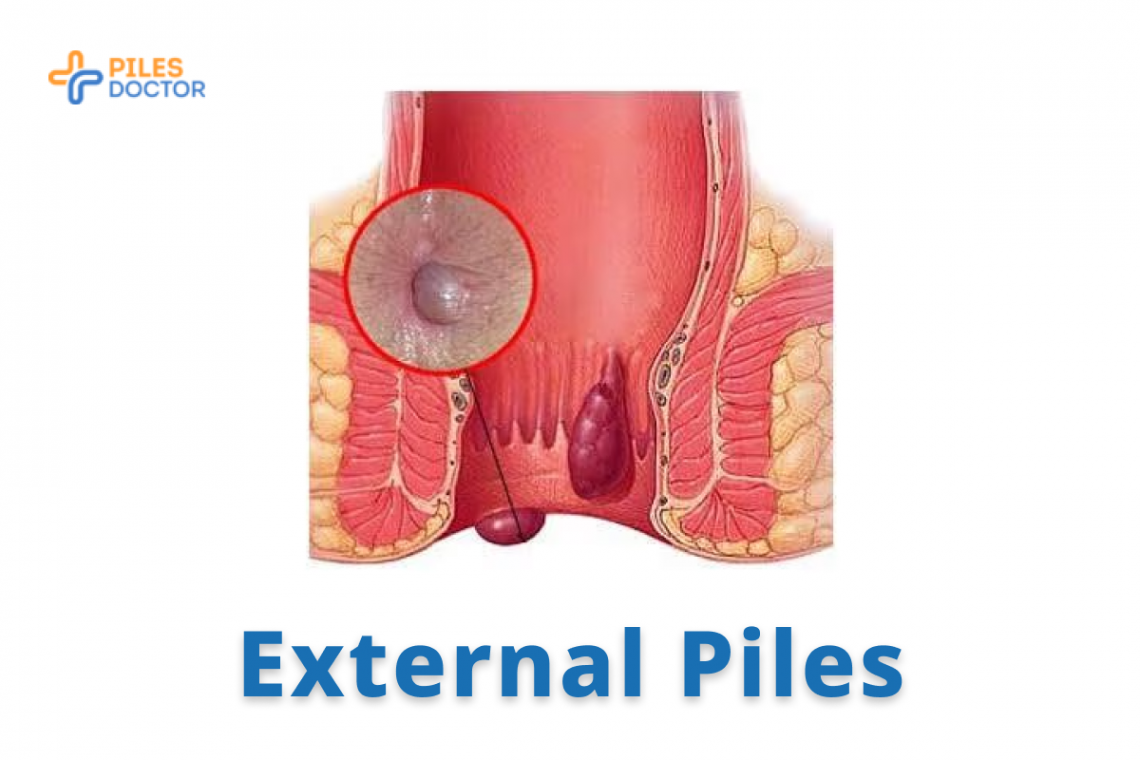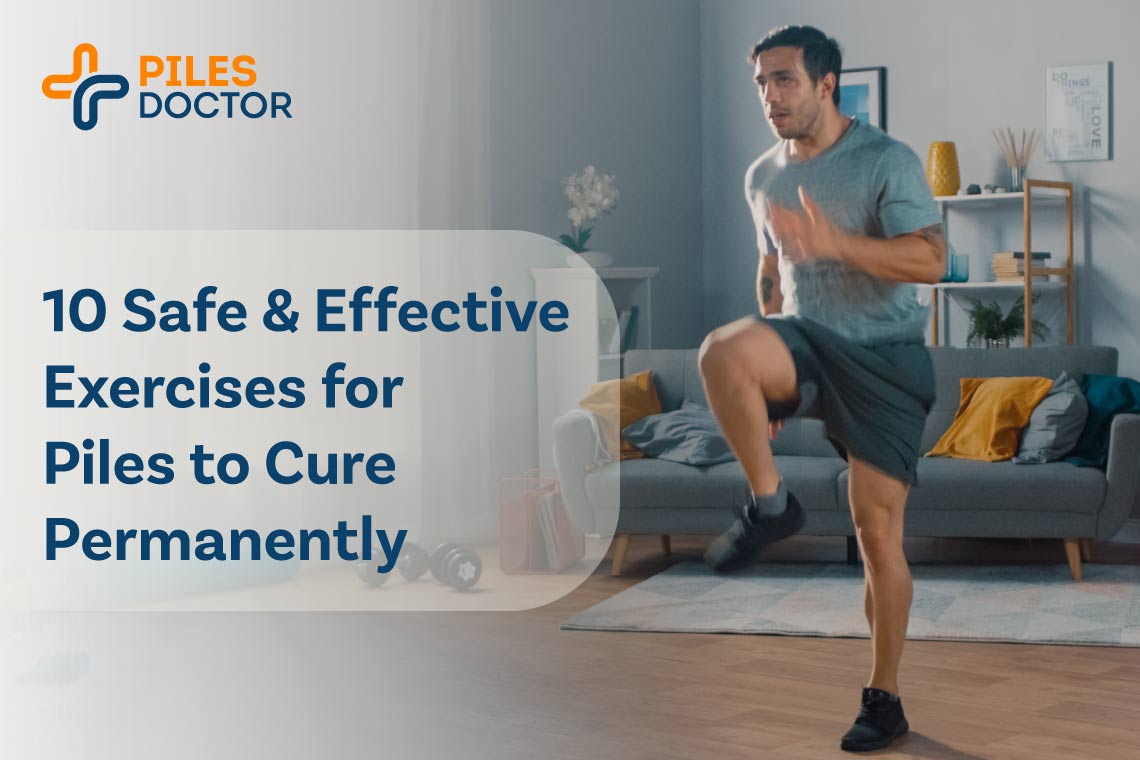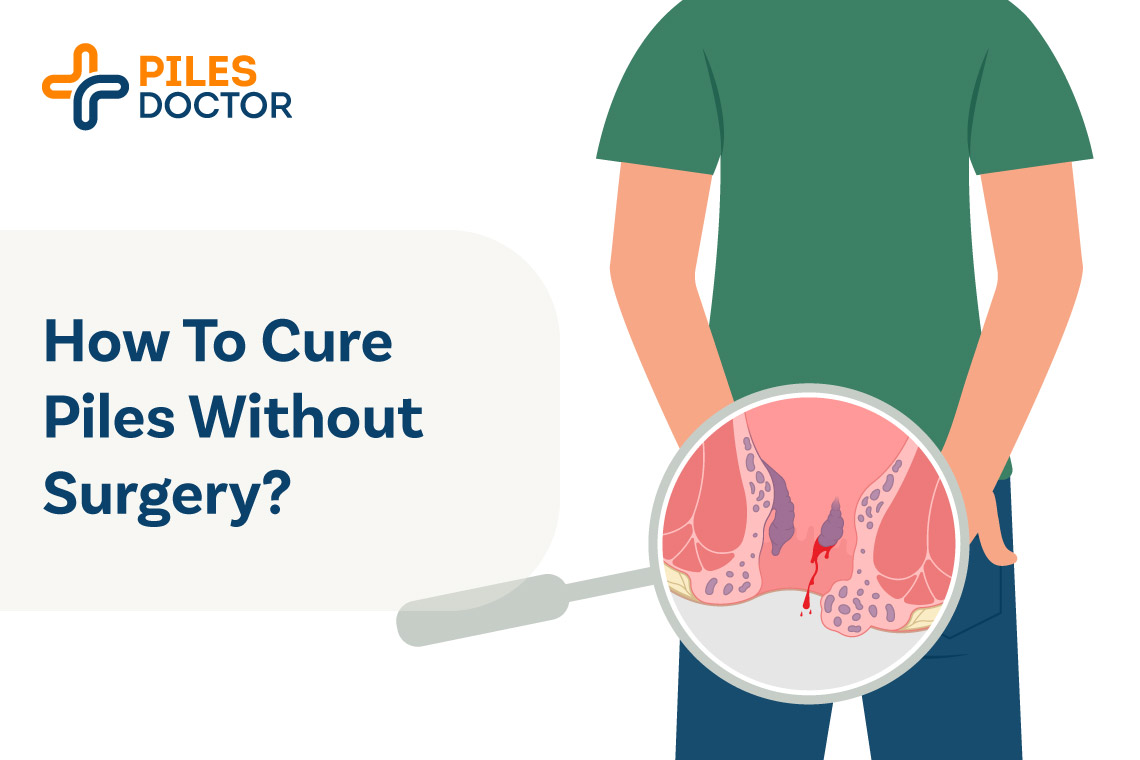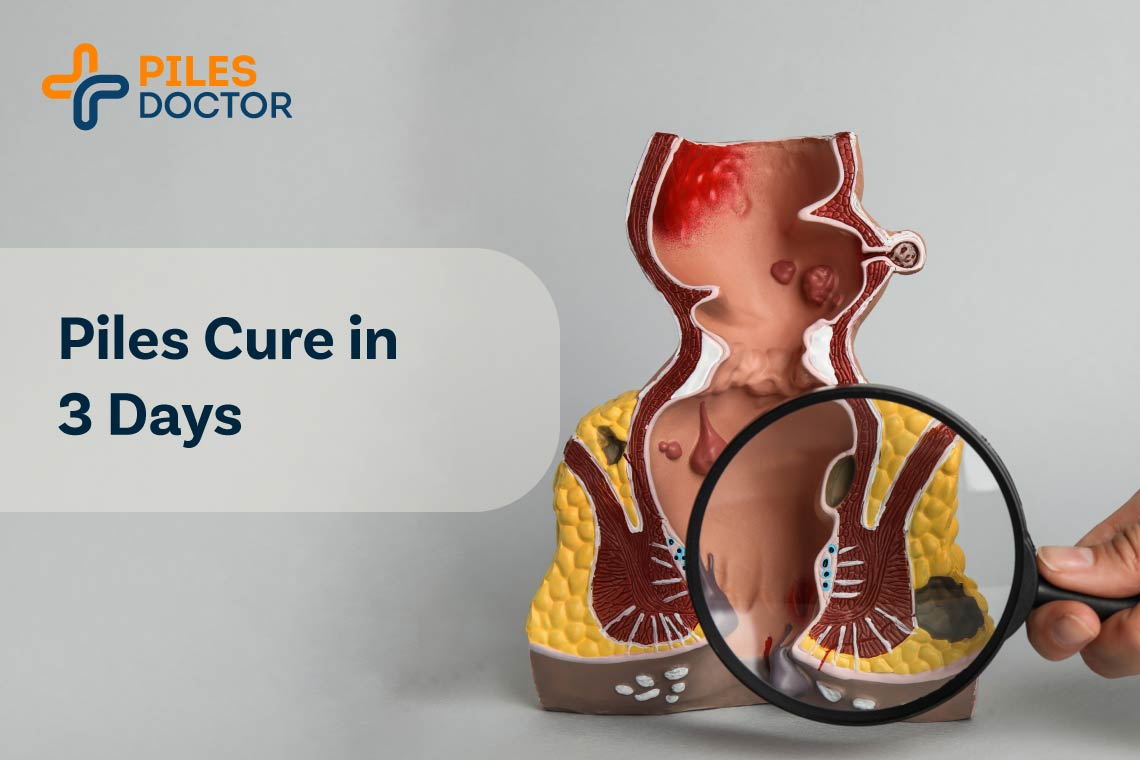External piles is swollen blood vessels outside the anus or lower rectum. They can cause extreme pain, discomfort, inflammation, and itching, especially during bowel movements. You may also experience bleeding or blood clots during or while wiping after bowel movements.
It is recommended to consult an experienced proctologist to seek proper medical attention on time.
How to Recognize the Signs of External Hemorrhoids?
There are a number of symptoms that may indicate the presence of external piles and may vary depending on the severity of the condition. Some common signs of external piles include:
- Swelling and Inflammation: You may feel swelling and inflammation around the anus if you have external hemorrhoids.
- Visible lump around the anus: You may feel hard lumps around the anus that feel sore and painful to touch.
- Difficulty Sitting or Moving: External piles can cause discomfort and pain, which may impair one’s ability to sit or move comfortably.
- Itching and Irritation: External piles can cause itching and inflammation which can interrupt your daily activities. You may feel a constant urge to scratch the anal area but it can make the piles even more worse.
- Bleeding: Bleeding is a common symptom associated with external piles. You may notice bright red blood during bowel movements or on the toilet paper while wiping.
- Pain and Discomfort: External hemorrhoids is quite painful and discomforting. Pain may range from mild to severe, depending on the severity of the condition.
- Thrombosis: In some cases, external hemorrhoids can develop blood clots, resulting in a condition known as thrombosed external hemorrhoids. This can cause severe pain and swelling, making it even more important to seek immediate medical attention.
If you are experiencing any of these symptoms, consult an experienced proctologist for a proper diagnosis and external hemorrhoids treatment.
Who is at the Risk of External Piles?
Individuals experiencing the following may be at an increased risk of developing external piles:
- Chronic constipation: Constipation is one of the most common causes of developing external piles. Straining during bowel movements can lead to swelling in anal blood vessels, which can lead to the development of external piles.
- Pregnancy: If you are pregnant, you may be at risk of developing external piles because the fetus’s weight and uterus exertion can lead to swelling in anal cushions that can cause external piles. Pregnancy is one of the main causes of external hemorrhoids in females.
- Diarrhea: Frequent bowel movements can strain the anal area, leading to the development of external piles.
- Aging: Adults aged 45 to 65 are at the highest risk of developing external piles. Aging weakens the blood vessels and contributes to the formation of external piles.
- Genetics: If you have a family history of piles, you might also get it. It indicates that your genes for anorectal muscles are more likely to weaken over time.
- Diet: If you are not taking enough fiber in your diet, then you are at risk of developing external piles because less fiber can lead to constipation, which is the most common cause of piles.
- Dehydration: Drinking less than eight glasses of water per day (roughly half a gallon) can contribute to constipation and, therefore, the development of external piles.
How are External Piles Diagnosed?
A proctologist may recommend some diagnostic tests to evaluate the severity of the condition. Some standard diagnostic tests performed before treatment include –
- Physical examination: In case of external piles, the doctor can diagnose it by physical examination.
- Medical history: During the consultation, the doctor may ask you some questions about the symptoms, medical history, family history of piles, etc.
- Digital rectal exam: The doctor may suggest a digital rectal exam (DRE), in which they insert a lubricated glove in the anus to feel the abnormalities.
- Anoscopy or Proctoscopy: The surgeon will use a small and lighted tool (anoscope or proctoscope) to diagnose the anus and rectum. This test helps assess the piles’ location, size, and severity.
- Sigmoidoscopy: During this test, the surgeon will use a sigmoidoscope (a lighted tube with a camera) to view the lower colon and rectum and diagnose the abnormalities.
- Colonoscopy: Colonoscopy examines the large intestine for abnormalities, including rectal bleeding from piles or other causes. It helps rule out serious issues, guiding the doctor in recommending external hemorrhoids treatment.
What is the Treatment of External Piles?
Here’re some commonly performed surgeries for external hemorrhoids, includes:
Open surgery
Open surgery is performed under general anesthesia so you won’t feel pain and discomfort. In this procedure, the surgeon makes an incision and accesses the piles.. Then the surgeon carefully excises the piles using surgical instruments and sutures the surgical site to interrupt blood flow.
It may take 2-3 weeks after the surgery to recover completely. Post-operative complications include bleeding, infection, surgical site wound, bowel incontinence, etc.
Laser surgery
Laser surgery is a minimally invasive and effective surgical option to treat external hemorrhoids. This procedure is performed under local anesthesia. In this procedure, the surgeon uses laser energy to remove or shrink the piles of tissues. Laser energy hits the piles tissues only and leaves the surrounding healthy tissues untouched. It offers faster recovery than open surgery for piles.
Laser surgery offers faster recovery and has minimal chances of post-operative complications that are common with traditional surgery.
Stapler surgery
In stapler surgery for piles, the surgeon uses a stapling device to remove piles tissues. This procedure is performed under general anesthesia. In this procedure, the piles tissue is lifted into a ring of tissues with sutures, and a stapler removes it, restricting blood flow to the tissue. There are fewer chances of complications such as bleeding, infection, or swelling around the anus, which are common with open surgery.
Complete recovery from stapled hemorrhoidectomy usually takes about two weeks. There are fewer chances of complications after the surgery.
Here’s a comparison table showing the difference between open, laser and stapler surgery.
| Basis | Open surgery | Laser surgery | Stapler surgery |
| Anesthesia | General anesthesia | Local anesthesia | General anesthesia |
| Incisions | One or more incisions | No incisions | Minimal incisions |
| Procedure | Excises surgically | Vaporized using laser energy. | Removed using stapler device |
| Recovery period | Longer recovery period | Faster recovery | Faster recovery |
| Post-operative complications | High chances of bleeding, infection, pain, wound etc | Minimal chances of complications | Less chances of complications than open surgery. |
| Cost | Range from INR 35,000 to Rs. INR 95,000 | Range from INR 45,000 to INR 55,000 | Range from INR 60,000 to INR 1.15,000 |
How is Recovery After Laser External Piles Surgery?
Recovery after laser piles surgery can take up to 5-8 weeks. It may vary for each individual depending on the severity of piles and the types of external hemorrhoids treatment followed.
Immediately after the surgery, you should take rest and avoid strenous activities.
One or two weeks after the procedure, you can return to your regular routine but avoid strenuous activities and heavy weightlifting.
Let us now look at some factors you should consider and what should be avoided after piles surgery to minimize discomfort and enhance recovery. Here are some effective steps:
Take a healthy diet: Immediately after the surgery, you can take a low-residue diet to prevent straining during bowel movements.
- Well-cooked vegetables
- Bananas (unripe bananas can cause constipation)
- Papaya
- Pudding
- White rice
Once you begin to heal, add more fiber to your diet. Some fiber-rich food includes:
- Beans
- Berries
- Whole wheat chapati
- Carrots
- Broccoli
- Apple
Stay hydrated: Fiber without water can cause constipation. It is essential to drink 6-8 glasses of water each day.
Stool softeners: You can take stool softeners or laxatives to ease bowel movements, prevent constipation, and minimize the chances of infection.
Recommended stool softeners are:
- Milk of Magnesia (magnesium hydroxide)
- Colace (docusate sodium)
- Metamucil (psyllium husk)
- Miralax (polyethylene glycol)
Sitz bath: Sitz bath helps you provide relief from post-operative pain and discomfort. You can add some additives to make the sitz bath more effective. Some additives are:
- Epsom salt
- Witch hazel
- Apple cider vinegar
Take medicines on time: You should take prescribed piles medicines on time. Don’t halt or start any medicine without the doctor’s consultation.
Avoid caffeine: You should avoid tea, coffee, and beverages, as they can lead to constipation and painful bowel movements even after the surgery.
Maintain hygiene: Keeping the surgical site clean and dry is essential. Use mild soap or soft tissues to wipe the area, especially after passing stool. Do not rub the area to clean as it leads to inflammation or a burning sensation around the anal area.
What If External Piles Is Left Untreated?
- External piles is extremely painful in itself and the pain can get even more severe if blood clots form in it. This condition is known as a thrombosed external hemorrhoid.
- Untreated external piles can be very itchy, if you scratch them, it can get even more worse.
- You may notice bright red blood on the toilet paper or in the toilet bowl after the bowel movement.
- If left untreated, external piles can lead to anemia due to excessive bleeding.
- Untreated external hemorrhoids can lead to strangulation if it become trapped outside the anus, they can cut off the blood supply, resulting in strangulation. Strangulated piles may require surgical intervention.
- It can negatively affect the quality of your life due to constant pain, bleeding, discomfort etc.
Piles is not a deadly disease, still you should not leave them untreated. It is important to consult an experienced proctologist to get a proper diagnosis and treatment on time.
What are the Home Remedies to Manage External Hemorrhoids Symptoms?
If you’re seeking ways for external hemorrhoids treatment without surgery, you can always try certain home remedies. Here are some commonly used home remedies to alleviate the symptoms of external piles.
- Take a bath in warm water: Warm water can help you soothe external hemorrhoids symptoms such as swelling and irritation. Take a warm bath in a tub and add Epsom salt, witch hazel, apple cider vinegar etc., in water to relieve inflammation, irritation and pain associated with external hemorrhoids.
- Cold compress: You can apply a cold compress to swollen areas for relief. For external piles, a cold compress can be very effective. Make sure to wrap the ice in a paper towel and apply it to the anal area.
- Garlic: Garlic is one of the best home remedies to treat external piles. It has antibacterial properties which can help reduce swelling, pain, inflammation or itching. You can make a paste of it and apply or consume it directly.
- Coconut oil: It is easily available in everyone’s household and can be the best home remedy for external hemorrhoids. Apply it to the external piles several times daily for the best results.
- Figs: Eating overnight-soaked figs can alleviate external piles symptoms. Additionally, it can prevent constipation and ease straining during bowel movements.
You should consult an experienced proctologist if the external hemorrhoids symptoms persist for over a week. If home remedies are not working, surgery is the only option to treat external piles.
What are the Foods to Eat and Avoid During External Piles?
Eating the right foods can help with piles, which are swollen veins in your rectum. To manage piles, it is important to eat a diet that is high in fiber and low in fat and sugar.
Here’s the list of foods that are good for piles.
High-fiber foods: Consuming foods that are high in fiber can help prevent constipation, which is a common cause of external piles. Include foods such as whole grains, fruits, vegetables, and legumes in your diet.
Water-rich foods: Stay hydrated by consuming water-rich foods like watermelon, cucumbers, and oranges. These foods can help soften the stool and make it easier to pass, reducing the risk of hemorrhoids.
Leafy greens: Add green leafy vegetables like spinach, kale, and broccoli into your meals. These vegetables are packed with fiber and can help promote regular bowel movements.
Flaxseeds: Flaxseeds are a good source of dietary fiber and omega-3 fatty acids. Adding flaxseeds to your diet can help improve digestion and reduce the external piles symptoms.
Prunes: Prunes are known for their natural laxative properties. Eating prunes or drinking prune juice can help soften the stool and relieve constipation, which can alleviate external hemorrhoids.
Foods to Avoid During External Hemorrhoids:
Spicy foods: Spicy foods can irritate the digestive system and worsen symptoms of external piles. Avoid foods like chili peppers, hot sauces, and spicy curries.
Processed foods: Processed foods are often low in fiber and high in unhealthy fats, which can contribute to constipation. Limit your intake of processed foods like fast food, frozen meals, and packaged snacks.
Alcohol: Alcohol can dehydrate the body and lead to constipation. It is best to avoid or limit your alcohol consumption when dealing with external piles.
Caffeine: Caffeinated beverages like coffee and tea can have a diuretic effect, which can dehydrate the body and contribute to constipation. Consider reducing your intake of caffeinated drinks.
Red meat: High consumption of red meat can lead to constipation due to its low fiber content. It is advisable to limit your intake of red meat and opt for lean protein sources like chicken, fish, and tofu instead.
Remember, incorporating a balanced diet with plenty of fiber, fluids, and healthy food choices can help manage external hemorrhoids and promote overall digestive health.
What are the Ways to Prevent External Piles?
While treatment options are available, preventing external piles is always better than dealing with the symptoms. Here are a few things you can do to prevent external piles –
Eat a healthy and balanced diet: You should include fiber-rich foods such as green leafy vegetables, fruits, whole wheat, etc in your diet to avoid constipation which is the main cause of piles. Fiber helps soften stools and prevent straining during bowel movements.
Stay hydrated throughout the day: Drink plenty of water and keep yourself hydrated throughout the day to prevent external hemorrhoids. Try to drink 6-7 glasses of water each day and avoid caffeine and alcoholic beverages as they can cause dehydration.
Avoid prolonged sitting and take breaks: if your job requires you to sit for prolonged periods, make sure to take ample breaks. It reduces continuous pressure from anorectal muscles. You should involve yourself in activities like walking, jogging and swimming, etc to promote a healthy digestive system.
Practice good toilet habits: The habit of surfing phone or reading books in the toilet can lead to piles. Avoiding sitting and standing for prolonged periods is key, since this causes increased pressure in the hemorrhoidsal veins. You should also avoid sitting on the toilet for longer than necessary. If you feel the urge to pass stool, don’t delay it. Responding to the body’s natural cues can help prevent constipation and reduce the risk of external piles.
Maintain hygiene: It is important to manage proper hygiene to prevent external piles. You should gently clean and wash the anal area with water and mild soap, after each bowel movement. Try to use moist tissues instead of rough toilet paper. Pat the area dry afterward, rather than rubbing, to avoid further irritation.
Don’t ignore the urge to go washroom: Ignoring the urge to go to the bathroom can lead to constipation, which is a significant risk factor for external piles. When you feel the need to pass stool, make sure to respond promptly and visit the bathroom. Ignoring this urge can cause the stool to harden, making it difficult to pass and increasing the risk of external hemorrhoids.
Maintain proper weight: Maintaining a healthy weight is crucial for preventing external piles. Excess weight, especially around the abdominal area, can put pressure on the rectal veins, leading to the development of hemorrhoids. Engaging in regular exercise and following a balanced diet can help you achieve and maintain a healthy weight, reducing the risk of external piles.
Summing Up
In conclusion, we can say external hemorrhoids can be painful or distressing but can be managed effectively by home remedies, lifestyle changes, and surgical intervention. Educate yourself about the condition and seek proper medical attention.
It is a common anorectal condition, usually in adults, and there’s no reason of embarrassment and silence. Just prioritize your health and avoid rumors about the external piles.




